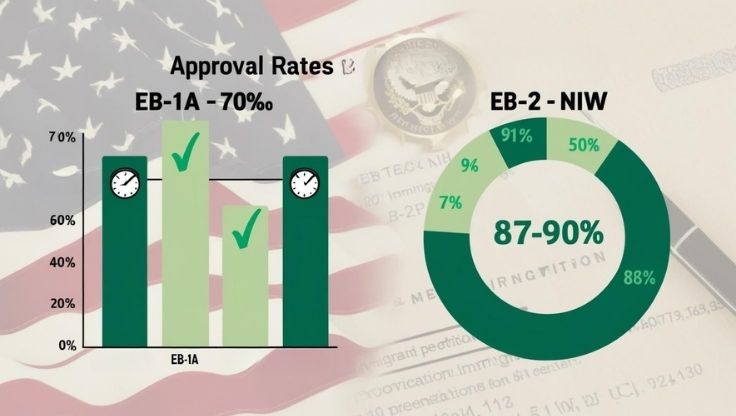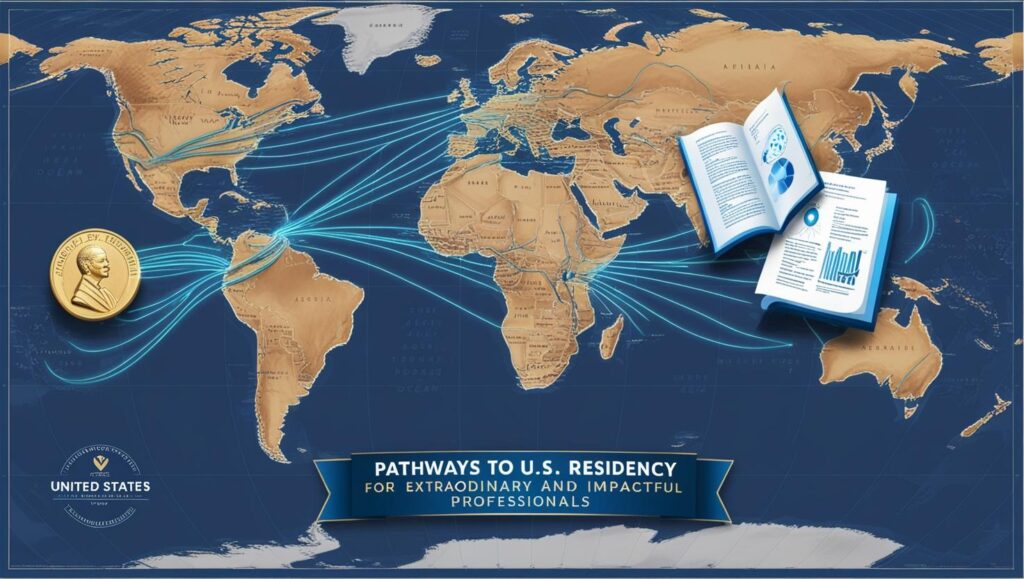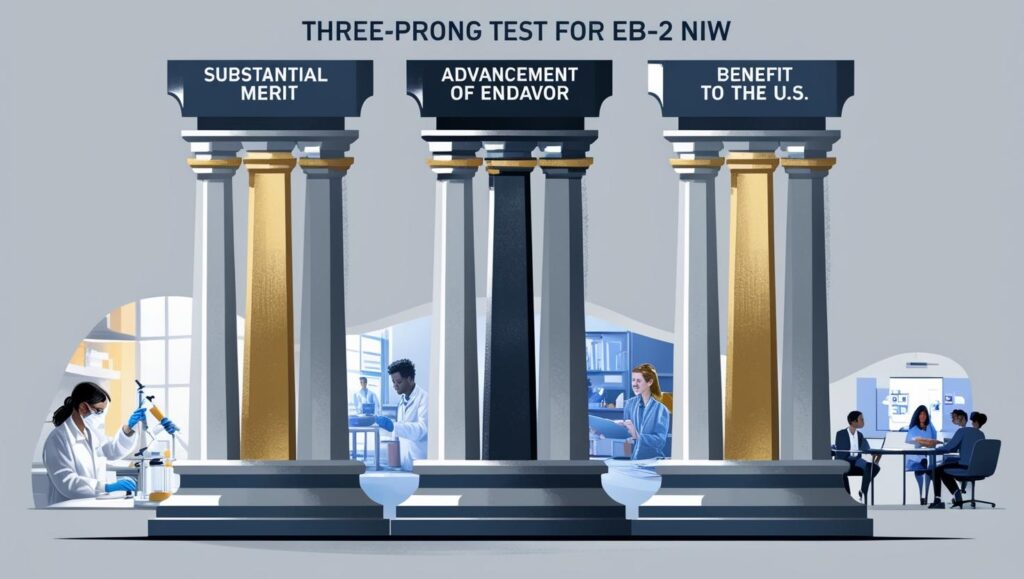Did you know that 100% of clients who used Green Card For Alien’s letter writing services were very thankful? They loved the personalized and attentive service they received. This shows how important it is to have expert help when dealing with employment-based immigration. Whether you’re looking at an EB-1A extraordinary ability green card or an EB-2 National Interest Waiver (NIW), knowing about approval rates and processes is key to your success.
Employment-based green cards are a way for skilled immigrants to get permanent residency in the United States. The EB-1A and EB-2 NIW categories are special because you can apply on your own, without needing an employer’s help. EB-1A is for people with extraordinary ability. EB-2 NIW is for those whose work greatly benefits the national interest.
Each category has its own rules, processing times, and approval rates. It’s important to understand these differences as you choose your immigration path. Let’s look at the main differences and similarities between EB-1A and EB-2 NIW. This will help you make a smart choice for your immigration journey.
Understanding Self-Petitioned Employment-Based Green Cards
Self-petitioned green cards are a special way to get permanent residency in the U.S. They let you apply for a green card without needing a job sponsor. This gives you more control over your future.
What Are Self-Petitioned Green Cards
Self-petitioned green cards are for skilled workers who want to live in the U.S. permanently. The EB-1A and EB-2 NIW categories are popular. You need to show you have an extraordinary ability or have made a big impact.
Benefits of Self-Sponsorship
Self-sponsorship means you have more freedom and control over your immigration journey. You don’t have to rely on a specific job. Deel Immigration has a 98% approval rate for these green cards.
Key Immigration Pathways Overview
EB-1A is for the top 1% in your field. It’s fast, with a 15-day premium service. EB-2 NIW is for those with advanced degrees or special skills. Both need a lot of paperwork and meet strict USCIS rules.

EB-1A vs. EB-2 NIW: Approval Rates for Green Cards and Waivers Explained
The EB-1A and EB-2 NIW green card categories offer different paths for talented professionals. Each has its own set of requirements, approval rates, and visa processing times.
EB-1A is known for its strict criteria and faster processing times. It’s perfect for individuals with extraordinary abilities who are at the top of their field. EB-1A applicants can self-petition and don’t need a job offer, making it a flexible option for high-achievers.
The EB-2 NIW category, on the other hand, is more inclusive. It’s for professionals with advanced degrees and exceptional abilities whose work benefits the national interest. While EB-2 NIW processing times may be longer, it offers a viable path for a broader range of applicants.
Approval rates for both categories are promising. EB-2 I-140 petitions see approval rates between 83% and 96%. However, EB-1A applications tend to receive more Requests for Evidence (RFEs), which can affect processing times.
Priority dates are key in determining when you can file for adjustment of status. EB-1A typically has more favorable priority dates compared to EB-2. Premium processing is available for EB-1A, potentially speeding up the process for eligible applicants.

EB-1A Extraordinary Ability Requirements and Criteria
The EB-1A green card is for those with extraordinary ability in their field. You need to show sustained national or international acclaim through significant achievements. This visa doesn’t need a job offer, making it appealing to many professionals.
Major Internationally Recognized Awards
Winning a major international award can prove your extraordinary ability. The Nobel Prize is a top example. Other awards like an Olympic medal or an Oscar also qualify. If you’ve won such an honor, you’re likely to get EB-1A approval.
Ten Qualifying Criteria Overview
If you haven’t won a major award, you can still qualify. You need to meet at least three out of ten criteria. These include being in elite associations, having a high salary, and published work about your field.
Other criteria cover original contributions, scholarly articles, and artistic exhibitions.
Final Merit Test Requirements
Meeting the criteria is just the beginning. You must also pass a final merit test. This shows your sustained national or international acclaim. The USCIS will look at your career achievements to see if you truly stand out.
National Interest Waiver Three-Prong Test Analysis
The National Interest Waiver (NIW) is a way to get permanent residency without needing a job offer or a PERM labor certification waiver. To qualify, you must meet certain requirements and pass a three-prong test. This test checks if your work benefits U.S. interests.
Substantial Merit and National Importance
Your work must have substantial merit and national importance. It should have great value and help the U.S. in a big way. For instance, research that leads to new medical treatments or innovations that boost the economy can qualify.
Advancement of Proposed Endeavor
You must show you can advance your work. This means highlighting your skills, experience, and past achievements. Your record should show you can successfully complete your project.
Benefit to the United States
Finally, you need to prove waiving the labor certification benefits the U.S. Your contributions should be more than the need for a job offer or labor market test. Your work should help with important national interests, like improving public health, advancing technology, or enhancing national security.
Remember, meeting these NIW requirements can lead to a nearly 100% approval rate. By providing strong evidence for each prong, you increase your chances of success in obtaining this valuable immigration benefit.

Processing Times and Priority Dates Comparison
USCIS processing times differ for various visa types. EB-1A petitions usually move faster than EB-2 NIW applications. The visa bulletin is key in knowing when to file for adjustment of status. EB-1A often has better priority dates, leading to quicker progress.
When priority dates are current, you can file I-140 and I-485 together. This means you can apply for your green card at the same time as your immigrant petition. The wait for an EB-1 green card for Indians is 2-4 years. This is much shorter than the 10-year wait for EB-2 or 14-year wait for EB-3.
USCIS workload and your country of origin affect processing times. The Department of State’s monthly visa bulletin gives the latest on priority dates and visa availability. Stay updated to navigate your immigration journey effectively.
Application Preparation and Documentation Requirements
Preparing for your I-140 petition can seem daunting. You’ll need to collect many documents to prove your eligibility. Let’s explore what you need to know about this process.
Required Forms and Supporting Evidence
The main form you’ll file is Form I-140. It currently costs $700, but will increase to $715 in April 2024. You’ll also need to gather lots of evidence. This could include awards, published work, or letters from experts.
Premium Processing Options
If you’re in a rush, consider premium processing. It costs $2,805 and ensures a 15-day review. This option is much faster than regular processing, which can take 5 to 8 months.
Documentation Strategies
Compiling your evidence is crucial. You want to clearly show you meet all the criteria. Many find it helpful to work with an immigration attorney. They can help you choose the right evidence and present it effectively. Remember, strong evidence compilation is key to a successful petition.
Success Rates and Approval Statistics
It’s key to know USCIS approval rates and immigration stats for those after employment-based green cards. We’ll look at success rates for EB-1A and EB-2 NIW categories.
Historical Approval Trends
EB-2 green cards have an average approval rate of 93%. This rate has changed between 83% and 96% over time. On the other hand, EB-1 green cards have an average approval rate of 80%, ranging from 51% to 89% from 2009 to 2019. The EB-2 NIW category shows approval rates between 81% and 93%.

RFE Response Rates
While exact RFE response rates aren’t given, it’s interesting to see EB-2 denial rates are very low. Indian applicants face a 6% denial rate, while Chinese applicants see only 4%. These figures show strong success rates for those who handle RFEs well.
Country-Specific Statistics
Recent visa success rates show interesting trends. China leads with 1,387 EB-2 NIW approvals, followed by India with 1,062. Nigeria, Brazil, and Iran round out the top five. It’s important to note that approval rates have been declining since fiscal year 2022, with the latest quarter showing a record low in EB-2 NIW approvals.
Conclusion
Understanding your immigration strategy can be tough. But knowing about green card options like EB-1A and EB-2 NIW is key. The visa comparison shows some interesting facts.
EB-1A is for those with extraordinary ability, with approval rates of 70-74% in 2022. On the other hand, EB-2 NIW has higher approval rates of 87-90%. This is because it’s a broader category.
Choosing between these green card options depends on your skills and career stage. EB-1A is for those with top achievements. EB-2 NIW is for professionals whose work benefits the national interest. Both allow you to self-petition, which is a big plus.
EB-2 NIW was more popular in 2022, with USCIS processing about 15,057 cases. This is compared to 7,418 EB-1A cases. NIW cases usually take three to nine months to process.
When deciding, think about your unique situation. It’s wise to talk to an experienced immigration attorney. They can help you make the best choice for your path.
FAQs
What are the main differences between EB-1A and EB-2 NIW visa categories?
The EB-1A (Extraordinary Ability) and EB-2 NIW (National Interest Waiver) are both employment-based green card categories, but they have distinct requirements. EB-1A is for individuals with extraordinary ability in their field, while EB-2 NIW is for those whose work is in the national interest of the United States. EB-1A has more stringent criteria, focusing on exceptional achievements, while EB-2 NIW emphasizes the importance of the applicant’s work to the country.
How do approval rates compare between EB-1A and EB-2 NIW petitions?
Approval rates can vary, but generally, EB-2 NIW petitions have a slightly higher approval rate compared to EB-1A petitions. This is partly because the EB-2 NIW category has more flexible criteria. However, approval rates can fluctuate based on various factors, including the strength of the application, current USCIS policies, and the specific qualifications of the applicant.
What are the key requirements for an EB-1A petition?
To qualify for an EB-1A visa, applicants must demonstrate extraordinary ability in their field through evidence of sustained national or international acclaim. This typically includes meeting at least three out of ten criteria set by USCIS, such as receiving major awards, having published material about the applicant’s work, or demonstrating a record of success in their field. The applicant must also show that their entry will substantially benefit the United States.
How does one qualify for an EB-2 NIW petition?
To qualify for an EB-2 NIW, applicants must show that their work is of substantial merit and national importance, that they are well-positioned to advance their proposed endeavor, and that it would be beneficial to the United States to waive the job offer and labor certification requirements. This can include demonstrating expertise in a field that benefits the nation, such as improving the economy, healthcare, or education.
Is labor certification required for EB-1A or EB-2 NIW applications?
No, labor certification is not required for either EB-1A or EB-2 NIW applications. This is one of the main advantages of these categories. For EB-1A, it’s automatically waived due to the extraordinary ability criteria. For EB-2 NIW, the “National Interest Waiver” specifically waives the labor certification requirement, allowing applicants to self-petition without an employer sponsor.
How long does the application process typically take for EB-1A and EB-2 NIW?
Processing times can vary, but generally, EB-1A petitions are processed faster than EB-2 NIW petitions. EB-1A processing can take anywhere from 6 to 12 months, while EB-2 NIW may take 12 to 18 months or longer. However, these timeframes can change based on USCIS workload and policy changes. Premium processing is available for EB-1A but not for EB-2 NIW applications.
Can I apply for both EB-1A and EB-2 NIW simultaneously?
Yes, you can apply for both EB-1A and EB-2 NIW simultaneously. This strategy, known as concurrent filing, can increase your chances of obtaining a green card. However, it’s important to note that this approach will require separate application fees and documentation for each petition. Consult with an immigration attorney to determine if this strategy is appropriate for your situation.
How do USCIS officers evaluate EB-1A vs. EB-2 NIW petitions?
USCIS officers evaluate EB-1A and EB-2 NIW petitions differently. For EB-1A, they look for clear evidence of extraordinary ability and sustained national or international acclaim. For EB-2 NIW, officers assess whether the applicant’s work is of substantial merit and national importance, and if waiving the labor certification requirement would benefit the United States. In both cases, the burden of proof is on the applicant to provide compelling evidence that meets the respective criteria.

